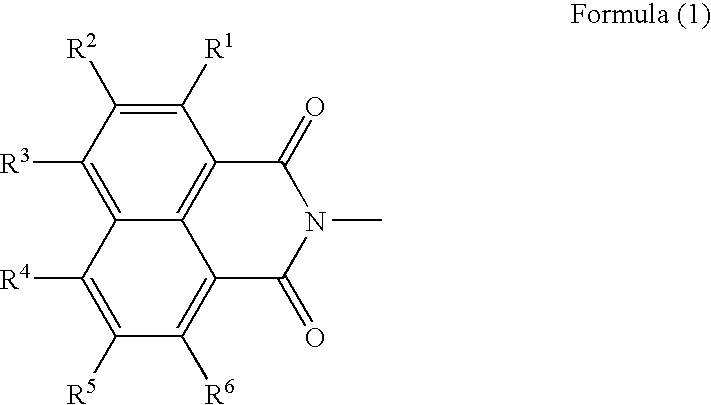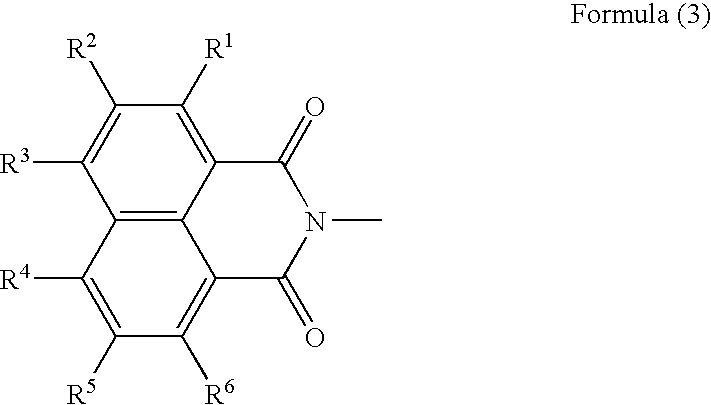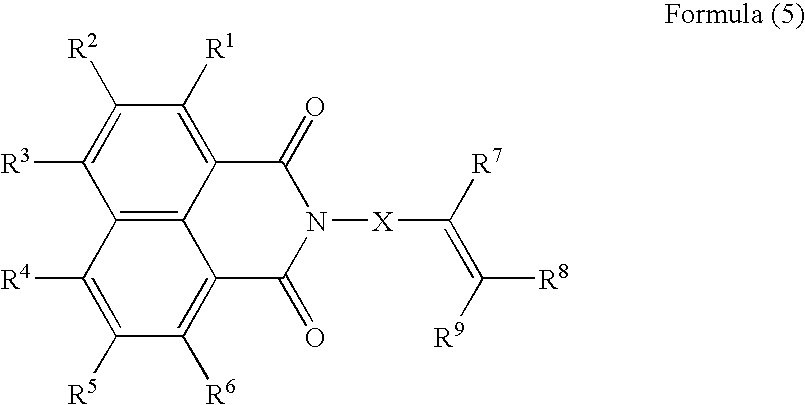Generally, the self-cleavage type has good sensitivity and high radical-generating efficiency, but is unstable to heat, giving rise to the problems concerning the
heat resistance, stability and preserving stability of a photosensitive resin composition containing this self-cleavage type.
Also, a photoradical initiator which has not been cleft and a decomposed material which has been cleft but not consumed in a radical reaction and deactivated is not bonded to a crosslinking structure of a matrix and exists as an independent component in a product, which impairs the quality of a layer.
For this, if a decomposed material originated from an initiator is left as it is, there is the problem that it causes deteriorated light resistance, coloring and
fading, peeling of a
coating layer and the occurrence of cracks or the like, which is a cause of a reduction in the reliability of a final product such as a layer insulation film and solder
resist in electronic parts and a
resist used for forming pixels in a color filter.
However, a large amount of a sublimated material originated from an initiator adheres to the inside of a heater and falls on a product obtained by curing during post-baking, causing product defects, posing a serious problem.
Also, a decomposed material of an initiator is involved in the
atmosphere around a heater, posing a problem from the viewpoint of
operational safety.
However, it is difficult to remove the residues completely because of volatilization from a
solid.
If the condition is made more strict to remove many more impurities originated from a
radical initiator, this condition rather causes product defects.
There is the problem that the use of a highly volatile initiator causes the occurrence of odors even after curing.
In this case, however, the photoradical-generating part introduced into the
side chain is a self-cleavage type and is easily decomposed by heating to produce a radical, still posing the same problems concerning, for example, the
thermal resistance, stability and preserving ability of a photosensitive resin composition containing this product.
Therefore, if the decomposed material is left as it is, it adversely affects the qualities of a
coating layer, and it is also difficult to remove the decomposed material perfectly by sublimation even if post-baking is carried out.
However, since the reactivity of the
maleimide is lowered on the contrary, there is the problem that the efficiency of
initiation of a radical reaction is dropped.
If it is intended to introduce an ethylenic unsaturated bond directly when forming the
maleimide group, there is a synthesis problem that polymerization of the ethylenic unsaturated bond is caused.
However, this causes a cost increase and also the subsequent refining process is complicated, giving rise to a synthesis problem in any case.
Although this agent reacts rapidly with a
vinyl ether, there is the aforementioned synthesis problem because this agent has a
maleimide group.
Because the maleimide group is not sensitive to the above wavelengths, use of maleimide for photocuring is involved with the problem that it is necessary to carry out
exposure by using a
light source having
light emission at a
wavelength of 350 nm or less.
Even if not
cut by a filter,
light emission intensity is weak, giving rise to the problem that
exposure time is made very longer than that required by a radical generator having absorption in a
wavelength of 365 nm in the case of using the same lamp.
However, these compounds are utilized for electrophotographic toners and these documents do not refer to the function of a naphthalimide group as a photoradical generator, the
thermal resistance of the naphthalimide and easiness of the synthesis of the naphthalimide.
Therefore, a problem concerning
operational safety, problems concerning a decline in the reliability of a final product such as deteriorated light resistance, coloring,
fading and peeling and cracks of a coating layer, a problem as to
short life of a
chemical solution and a problem concerning the generation of an
odor can be all solved.
Furthermore, a reaction for forming a maleimide structure does not proceed without a
dehydration condensation reaction, for example, by heating or by using a catalyst.
For this, there are various synthesis problems.
Therefore, a problem concerning
operational safety, problems concerning a decline in the reliability of a final product such as deteriorated light resistance, coloring,
fading and peeling and cracks of a coating layer, a problem as to
short life of a chemical solution and a problem concerning the generation of odors can be all solved.
Furthermore, a reaction for forming a maleimide structure does not proceed without a
dehydration condensation reaction, for example, by heating or by using a catalyst.
For this, there are various synthesis problems.
If the compound (c) which is an essential component is contained, it can cause curing and / or a change in
solubility even in the case of a photosensitive resin composition having no ethylenic unsaturated bond.
As a result, a problem concerning deteriorated reliability of a final product is solved.
Therefore, a problem concerning operational safety, problems concerning a decline in the reliability of a final product such as deteriorated light resistance, coloring, fading and peeling and cracks of a coating layer, a problem as to
short life of a chemical solution and a problem concerning the generation of odors can be all solved.
Furthermore, a reaction for forming a maleimide structure does not proceed without a
dehydration condensation reaction, for example, by heating or by using a catalyst.
For this, there are various synthesis problems.
As a consequence, a problem concerning operational safety, problems concerning a decline in the reliability of a final product such as deteriorated light resistance, coloring, fading and peeling and cracks of a coating layer, a problem as to short life of a chemical solution and a problem concerning the generation of odors can be all solved.
As a result, the problem concerning a reduction in the reliability of a final product is solved.
Also, even in the case of a photosensitive resin composition dissolved in a transparent state by using a
solvent, precipitates are produced in the coating layer during
drying when the
solvent is evaporated at a coating process in the case where the compatibility among solids contained in the resin composition is low and only insufficient transparency is obtained.
In the case where the
acid anhydride has a five-membered cyclic structure like a
phthalic acid anhydride and
maleic acid anhydride, the reaction proceeds in two stages as described above and therefore no
imide is formed if the dehydration condensation reaction using heat, a catalyst or the like is not run, giving rise to various synthetic problems.
Furthermore, a reaction for forming a maleimide structure does not proceed if a dehydration condensation reaction is not promoted, for example, by heating or by using a catalyst.
For this, there are various synthesis problems.
When the amount of the
macro molecular weight binder component containing no ethylenic unsaturated bond is more than 97% by weight, photocurability tends to be deteriorated.
When other photoradical generator is used together with the compound (a), the other photoradical generator possibly produces
decomposition materials, giving rise to problems concerning discoloration and physical properties of the cured film,.
vaporization of
decomposition materials and stability and preserving ability of the photosensitive resin composition or the like.
However, because the amount of the other photoradical generator can be decreased by using the compound (a) together, the above problems arise with more difficulty than in the case of using only other photoradical generator.
Even if these problems arise, the problematic level is low.
If the proportion is less than 0.1% by weight, it is difficult to exhibit the effect of the added additives whereas if the proportion exceeds 95% by weight, the ratio of the resin composition is small and thus it is difficult to reflect the characteristics of the resin composition upon a final product.
When components absorbing the light emitted from a
irradiation light source are compounded in a large amount in the photosensitive resin composition, the light insufficiently reaches the compound (a), decreasing sensitivity.
However, because it is a self-cleavage type radical generator, impurities arise in the coating layer, causing coloring in the comparative composition A2 containing Irg 907.
Therefore, a problem concerning operational safety, problems concerning a decline in the reliability of a final product such as deteriorated light resistance, coloring, fading and peeling and cracks of a coating layer, a problem as to shortening of the life of a chemical solution and a problem concerning the generation of odors can be all solved.
Furthermore, a reaction for forming a maleimide structure does not proceed without a dehydration condensation reaction, for example, by heating or by using a catalyst.
For this, there are various synthesis problems.
As a consequence, the residue originated from the photo
radical polymerization initiator of the present invention does not give rise to a problem concerning operational safety, problems concerning a decline in the reliability of a final product such as deteriorated light resistance, coloring, fading and peeling and cracks of a coating layer, a problem as to short life of a chemical solution and a problem concerning the generation of odors.
 Login to View More
Login to View More 


